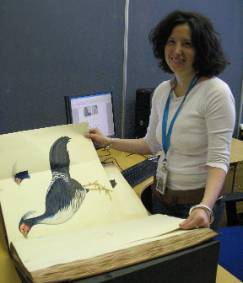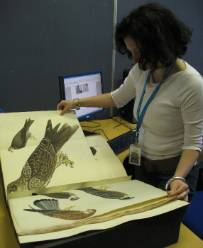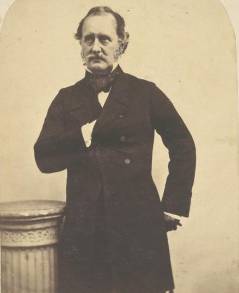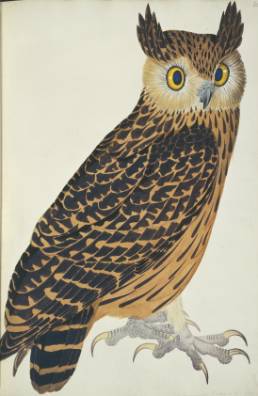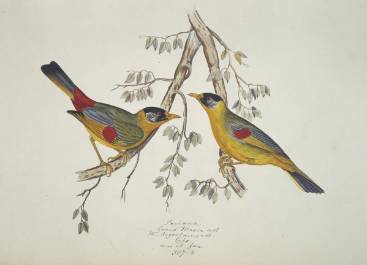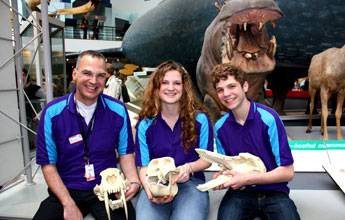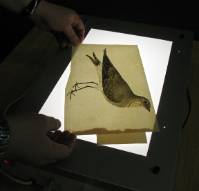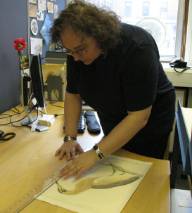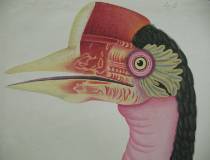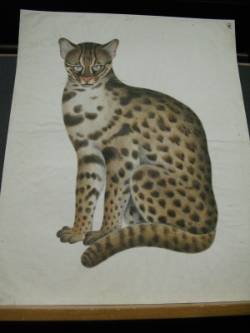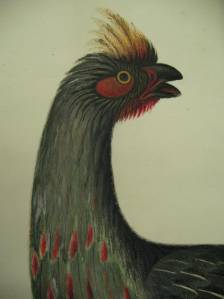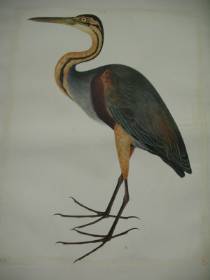Claudia Cardillo has been volunteering in the Library for one day a week since February 2011. During the rest of the week she works as a member of the Museum's Visitor Services team and she has worked here for the past two years.
Claudia is working on the Hodgson collection, which consists of about 1,400 pieces of art. She is unlocking the collection by examining each of the individual items and recording all the information about the specimen (if given). She also notes down any issues with its condition (tears, etc.) and any other useful information, such as the artistic techniques used.
"I have a degree in the History of Art, from the University of Naples, Italy, where I am originally from. I love art, and the collection that I am working on is wonderful! I wanted to develop my cataloguing and research skills, as I thought these would be particularly good skills for the future. The Hodgson collection is amazing, and I am really enjoying working in the Library."
Who was Brian Houghton Hodgson (c.1800-1894)
Born in Cheshire in about 1800, Brian Houghton Hodgson studied at the East India Company’s Haileybury College from 1816 –17, before sailing to Calcutta to take up an administrative position with the Company. Unfortunately he suffered from ill-health, and was transferred to Kumaon in the foothills of the western Himalayas to recover. In 1820, he was promoted to the position of Assistant Resident to the Court of Nepal, but finding little to do in Kathmandu, he returned to the bustle of Calcutta. There he was again taken ill, and moved back to Kathmandu, becoming acting Resident and finally Resident of Nepal in 1829 and 1833 respectively. After 23 years of service in Nepal, Hodgson resigned in 1843. Following a short sojourn in England, he returned to India in 1844 and lived in Darjeeling, a town close to the Nepalese border, until 1858 when he returned to England.
Brian Houghton Hodgson
(NHM image reference 037022)
Hodgson’s role as Resident of Nepal was not a demanding one, and so he had plenty of time and the financial resources to undertake a thorough study of the natural history of Nepal. He became fascinated with the culture of Nepal, Himalayan Buddhism, architecture, ethnography and linguistics. He is also considered responsible for the introduction of the Gurkhas into the British Indian Army.
Hodgson had a special interest in the birds and mammals of Nepal and the surrounding Himalayan region. He discovered many new species and wrote more than 140 scientific papers. Hodgson’s zoological papers are particularly interesting as he described the animals’ habits and habitat in great detail. As he was unable to travel freely around Nepal, he relied heavily on the knowledge of local people to provide him with these observations. He also kept a number of wild animals in captivity. Hodgson made vast collections of specimens; over 10,500 specimens were donated to the British Museum.
Ketupa flavipes (tawny fish owl)
(NHM image reference 037033)
What is the Hodgson Drawings Collection?
Hodgson commissioned thousands of drawings of birds and mammals from Nepalese artists. These artists were trained by Hodgson to paint in the style required for scientific illustration. The drawings accurately depict the natural colours and external anatomy required for scientific identification. Hodgson frequently dissected his specimens to show the skeletal and other anatomical features, and encouraged artists to sketch these extra details on the drawings. He would also frequently add his own detailed comments on the side. Unusually, the names of some of Hodgson’s Nepalese artists are known. Rajman Singh was a Nepalese draughtsman who worked for Hodgson for many years. Some of his drawings were published in articles written by Hodgson in the Calcutta Journal of Natural History and Asiatic Researches. There is one signed bird painting by him in the collection. Another artist who worked for Hodgson was Tursmoney Chitterkar of Nepal, but currently nothing is known about his life.
Leiothrix argentauris (silver-eared mesia)
(NHM image reference 037039)
Hodgson intended to publish a lavish book on the mammals and birds of Nepal, illustrated with hand-coloured plates. As part of this project he arranged for his collection of drawings to be duplicated, to produce a set suitable for reproduction. Despite Hodgson’s strenuous efforts, the book was never published. A deeply disappointed man, Hodgson disposed of his drawings and specimens to several institutions in England, including the British Museum. In recognition of the size and importance of Hodgson’s collections, the Keeper of Zoology at the British Museum, J. E. Gray, published catalogues of Hodgson’s collections in 1846 and 1863. The British Museum was also the recipient of over 1,400 paintings of birds, mammals, reptiles and fish. These were later transferred to the Natural History Museum.
Petaurista magnificus (Hodgson's giant flying squirrel)
(NHM image reference: 025019)
References and further reading
Cocker, M. & Inskipp, C. (1988) A Himalayan ornithologist: the life and work of Brian Houghton Hodgson. Oxford University Press: Oxford. 89pp.
Hunter, W.W. (1896) Life of Brian Houghton Hodgson. John Murray: London. 390pp.
Gray, J.E. (1846) Catalogue of the specimens and drawings of Mammalia and birds of Nepal and Thibet presented by B.H. Hodgson Esq. to the British Museum. British Museum: London. 156pp.
Gray, J.E. (1863) Catalogue of the specimens and drawings of Mammalia and birds of Nepal and Tibet presented by B.H. Hodgson Esq. to the British Museum. 2nd ed. London. 90pp.
Waterhouse, D. (2004) The origins of Himalayan studies: Brian Houghton Hodgson in Nepal and Darjeeling. RoutledgeCurzon: London.
These books can be found on the Library catalogue.
Want to learn more about volunteering at the Natural History Museum, London?
We’re evolving….please bear with us!
We’ve just revamped our Volunteering and Internship web pages and changed to a new e-recruitment system. Please click here to find out more about our volunteer offer and how to go about searching and applying for current vacancies:
http://www.nhm.ac.uk/about-us/jobs-volunteering-internships/index.html
E-ALERTS
New and existing users
Currently our vacancy e-alerts are unavailable due to the e-recruitment system change over; please bear with us and this will be sorted as soon as possible in the forthcoming weeks.
Equally if you have already signed up for our e-alerts with us then you will need to sign up again when the new alerts are available. We will let you know via the web pages as soon as this happens.
To monitor current job, volunteer and internship vacancies please search as normal using the drop down menus as part of the Vacancy Search.
Internships
We will next recruit for interns in the summer (July) for internships to be carried out in autumn and winter. We offer internships in four areas: Marketing, Press Office, Fundraising and Interpretation & Design.



